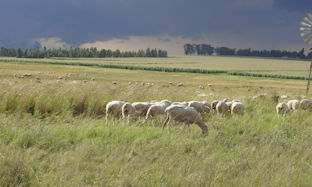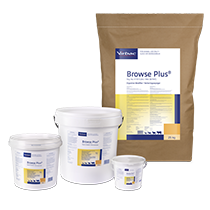
SHEEP MANAGEMENT PRE-LAMBING: Nutrition & Body Condition
This is article 2 of 6 articles on this topic
Late pregnancy (2 months pre-lambing) is a good time to assess the condition of the ewes and to make nutritional adjustments if necessary. Ewes with long wool can fool you and make you overestimate the condition! It is therefore important not only to look at the appearance of the ewes, but to physically score them through palpation. Start sooner rather than later to improve the condition of ewes! Ewes should be in a minimum body condition point of 3 . at lambing, but preferably 3.5.
The nutrition/condition of the ewes before/during lambing is crucial for the following reasons:
Development of the unborn lamb(s):
We know that most foetal growth (85%) occurs in the last 4-6 weeks of pregnancy. The nutrition of the ewe must be able to fully develop the unborn lamb(s) AND maintain or increase the condition of the ewe. This is especially critical in ewes carrying multiples! This will benefit the survival capacity (vitality) of the lamb(s) - especially during adverse weather conditions during birth.
Birth mass is critical to the survival of newborn lambs. Although breed and birth status play a role, it appears that the optimal birth weight for single, twin and triplet lambs is approximately 5.5 kg; 5 kg and 4 kg respectively, with 3.5 kg as the absolute lower limit.
Although not a common problem, overfeeding during this time can be detrimental. This can lead to the birth mass of the lambs increasing to such an extent (especially single foetuses), that problems with difficult births can occur.
Influence on re-conception:
Ewes must be in ideal condition before lambing to ensure good re-conception. This is not only important in accelerated lambing systems where it is extremely critical, but also in 12 month lambing systems. It has been proven that ewes that are not in good condition during lambing, have a lower conception rate at the next mating - even if the ewes are then in ideal condition! This has to do with the fact that the follicles that will shed the ova to be fertilised during the next mating season, starts to develop shortly after giving birth. These follicles will only develop optimally if the condition of the ewe at lambing is adequate to prevent a critical drop in body condition after lambing.
Influence on udder development, udder quality and milk production:
Feeding in late pregnancy has a direct influence on udder development. Udder development in turn has an influence on colostrum production (quantity and quality), as well as milk production during lactation. Udder development and colostrum production cannot be corrected by post-lamb feeding. Milk production can be increased to some extent by good nutrition after lambing.
The provision of supplementary feeding which a high percentage of bypass protein in the late phase of pregnancy, is important for good udder development and colostrum production. Supplementation containing high levels of urea in this phase may restrict udder development. The appearance of thick/tough colostrum which is difficult for lambs to ingest, is associated with supplementary feeding which high levels of urea and/or where ewes receive a high energy diet (grains) without sufficient bypass protein.
Prevalence of metabolic diseases
Ewes whose condition is not sufficient in late pregnancy can easily get pregnancy toxaemia (“domsiekte”) - especially with ewes carrying multiples which limit the rumen space even further. Pregnancy toxaemia develops when the nutrition is of such a nature (poor quality and/or quantity) that ewes have to break down their own body fat to try to meet their own and the unborn lambs' nutritional needs.
An energy deficit leads to low blood glucose levels and blood glucose is needed to break down fat. If there is already a shortage of blood glucose, the body fats are not fully broken down into energy and a breakdown product, which is formed during the breakdown process, is converted to ketones which then accumulate in the blood. The low blood glucose level together with the accumulation of ketones in the blood gives rise to a clinical condition commonly known as "domsiekte". A secondary consequence of the disease is liver damage and impairment of the nervous system.
“Domsiekte” is a very serious disease and ewes that develop “domsiekte” seldomly survives.
- If ewes lamb in lambing pens, they must be acclimated to the ration they will receive in the lambing pens two to three weeks before the expected lambing date. A sudden change in feed can lead to nutritional disturbances such as acidosis (“suurpens”) and diarrhea which must be avoided at all costs, as this will negatively affect the ewes' colostrum and milk production and increase lamb mortality.
- Follicle development - the foetus is directly influenced by the nutrition of the ewe:
- reproduction - it is important to remember that the lifetime number of follicles in the ovaries of ewe lambs, is already deposited in their ovaries 50 days before their birth. Therefore, the nutrition of pregnant ewes is essential in determining the lifetime reproduction rate of their ewe lambs
- wool production - in wool sheep, the wool-producing follicles are already established and developed from before birth to shortly after birth. Primary follicles (stronger fibres) develop from 50-90 days of pregnancy and secondary follicles (finer fibres) from 90 days of pregnancy until shortly after birth.
If the ewes therefore have a condition score of 2.5 or less 8 weeks before the lambing season, their nutrition must be drastically adjusted - especially if there are not yet good grazing conditions (quality and quantity), or prospects for that. The provision of good quality hay/silage and/or a production lick can help to improve the condition. Discuss the supplementation and its intake with a nutritionist to make sure it will be effective.
The inclusion of a digestion modifier (if not already part of the supplement) is highly recommended when nutritional conditions are marginal. If it is already included, ensure that the intake during this time is at least 2g/d/ewe to have maximum effect.


